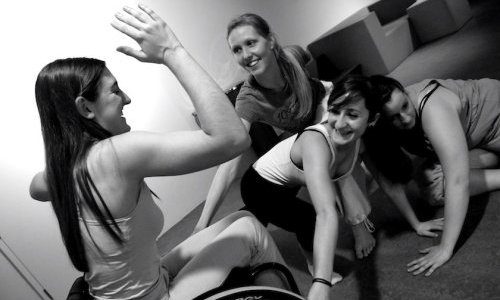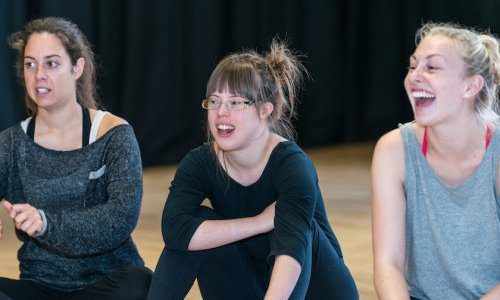
Candoco Dance Company: it’s about what you can do not what you can’t
Candoco Dance Company exists to change people’s perception of disability, and highlight what people can do, not can’t. An ethos close to Disability Horizon’s heart, so we were keen to speak to them about their recent performance, Playing Another, and up and coming projects in the future.
Please can you tell Disability Horizons readers a bit about Candoco Dance Company and how it first came about?
Candoco Dance Company is an inclusive dance company of disabled and non-disabled artists. We aim to challenge and broaden perceptions of art and ability by creating excellent and ground-breaking performances. We have been touring all over the world since the company was first founded in 1991 and we’ve had the opportunity to work with many of the world’s leading choreographers and perform in iconic venues.
The company was founded in 1991 by Celeste Dandeker-Arnold and Adam Benjamin. It developed from inclusive dance workshops with disabled and non-disabled dancers, and quickly grew into the first company of its kind in the UK – a professional dance company focused on the integration of disabled and non-disabled artists.
Celeste’s priority was that Candoco should be programmed and considered in the same way any leading contemporary dance company is. She didn’t want people to see it as some sort of therapeutic project.
In 2007 myself and Pedro Machado took over the role of Artistic Co-Directors when Celeste retired.
You are currently touring in the UK with a show titled Playing Another, can you tell us a bit about that?
Playing Another is a double bill featuring work by Thomas Hauert and Hetain Patel.
Let’s Talk About Dis, part of the performance, is choreographed by visual artist Hetain Patel and, as the title suggests, it’s a very frank piece that challenges the audience to think about how they view disability and disabled artists.
This was a really interesting commission for us because Hetain is not a self-described choreographer or dancer, and he had never previously made work that he himself had not performed in.
His most recent solo work American Boy is a huge success and sold-out at Sadler’s Wells and, like most of his work, it has a strong autobiographical theme. Hetain is very concerned with issues of identity and his work asks the questions: what makes us who we are? How do other people see us and how does that impact on how we see ourselves?
For Candoco as a company and for the individual dancers working in our company these were very appropriate and provocative questions to explore as the basis for a piece. It’s a really funny piece and, although it’s quite provocative, it finds a lovely common ground with the audience. Hetain uses humour as a way of engaging with the audience, so it is not shocking or accusing of an audience, but it still provokes them to consider some very important issues.
Thomas Hauert is one of Europe’s most innovative choreographers, having developed a very specific way of making work that creates improvisational structures with the dancers that are different in each performance.
When we approached Thomas he said he would like to create a piece that was inspired by the Italian documentary Tosca’s Kiss. Tosca’s Kiss is about the world’s first retirement home for retired opera singers. It’s a really touching film and we thought it would be fascinating inspiration for a dance piece with Candoco – it has melodrama, humour and of course opera. The resulting piece, which is called Notturnino, has these beautiful moments of crescendo and drama, and then more intimate, still moments.
What did you do to prepare for the UK Tour?
Our Producer and Communications Manager do a lot of work on firstly booking the tour, contacting the theatres to find out who is interested in having the show and then working on a marketing campaign to ensure that audiences know we are coming to their theatre. As part of the audience engagement we often offer workshops or talks with the company before or after the show, so we have to plan and prepare for these. And of course we have to practice doing the show, both in the studio and on stage before the audience is invited in!
In 2012 the Cando dancers performed a routine at the Paralympics closing ceremony – can you describe what that moment felt like?
It was really very special to be performing in the Olympic Stadium, knowing that millions were watching across the world. I was so proud of Candoco being chosen to be there. We performed a new routine choreographed especially for us and 12 other commercial dancers, dancing with spears with live fire to Coldplay’s Yellow. I think I still have gold make up under my fingernails to prove it!
What things do you need to consider when choreographing a routine for people with a disability?
You need to consider if you want the dancers to adapt what you already have made yourself, which is possible, but takes time in order to figure out how it may work differently for another person’s body. Instead, many of the choreographers we work with come in with creative ideas instead of exact steps, and this is often a great way to let individual dancers shine and offer their best moves.
Putting a routine together must be a challenge for all involved, but what steps does the chorographer take to incorporate the person’s individual needs and abilities into the dance?
As Kim Gavin (choreographer for the Paralympics) found out, working with disabled dancers opened up for new choreographic ideas. For example, there was a section that we danced lying on the floor. The dancers in wheelchairs just did that section sitting in their chairs, still dancing the same movements, but with their arms and upper body. They therefore effectively created a counterpoint to the dancers on the floor, rather than not being part of it.
Disabled dancers usually have great knowledge of what their bodies can do, so if the choreographer is willing to engage in figuring out what will work well, there is no limit to new dance moves that can be made.
How do you remember the steps to a dance routine?
With lots of practice! For some dancers, it helps to make a story or a string of images connected to the dance moves, to help remember them. For others, the body memory takes over and by practicing again and again the movement seems to ‘stick’.
Often in contemporary dance the dancers make up their own movements according to a task, and then it can be useful to remember the task in order to perform the movement again and again.
What has been your most memorable performance?
There are too many to choose from! But recently it was really beautiful to see the new cast perform Thomas Hauert’s Notturnino at the Bournemouth Dance Pavilion. And of course the Paralympics Closing Ceremony in 2012 was pretty special!
What are the future plans for Candoco?
We have an exciting project coming up in 2015, The Show Must Go On by Jerome Bel, with a cast of 20 performers. It is going to some pretty big theatres around the UK in Spring 2015 – Sadler’s Wells, Nottingham Playhouse and Tramway, Glasgow.
We are also excited about plans for our youth company, Cando2, who have been performing with us at Queen Elizabeth Hall this December, and who will be making more ambitious performance work over the next few years.
By Zubee
If you’re interested in getting into dance, visit the Condoco Dance Company website.
Check out…
- Challenging impaired perceptions of disability
- Disability and Christmas parties: bring on the many misadventures
- Disability behind and in front of the camera
Are you interested in dance and performing? We’d love to hear from you. Get in touch by messaging us on Facebook, tweeting us @DHorizons, emailing us at editor@disabilityhorizons.com or leaving your comments below.



